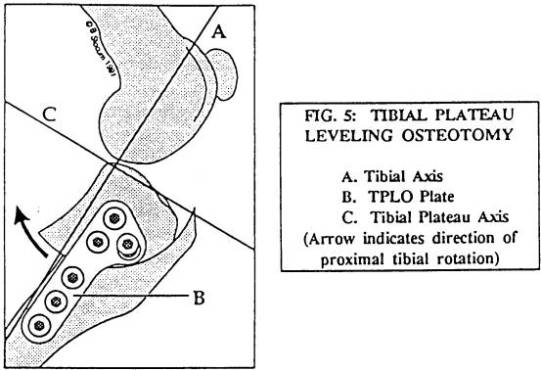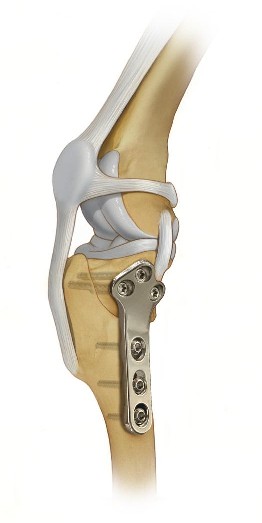TPLO, also known as Tibial Plateau Leveling Osteotomy, is a surgical procedure in which the head of the tibia is surgically altered and plated to create a new joint angle. A new angle is created in the stifle to prevent the femur from sliding off of the tibia. This is a very invasive procedure, as it involved the surgical cutting and plating of bone, and as with all surgery, there is a risk of both operative and post operative complications which need to be taken into consideration before going forward with a TPLO.
How the TPLO procedure is performed:
First, the torn ends of the cranial cruciate ligament will be completely removed by the surgeon. Next, the medial and lateral meniscus cartilages will be examined for any signs of damage. The medial meniscus is damaged in about 50% of dogs with CCL ruptures, and the damaged meniscal cartilage will also be removed so as to not hinder the healing process or cause any additional discomfort. Your dog’s veterinarian will take care to remove only the parts of the meniscus that have been damaged as a result of the unstable femur bone pinching the meniscus during normal activity. Studies have shown that dogs with partial menisectomies have less arthritis than dogs with complete meniscus removal.

After the CCL has been removed and meniscus examined, the surgeon will begin the osteotomy. Simply translated, osteotomy means removal of bone, and in the first part of the TPLO procedure the surgeon will make a curved cut in the top of the tibia bone, to include the tibial plateau. The tibial plateau is then rotated along the curved osteotomy in order to level the slope. Hold the tibial plateau in place is a set of plates and screws, necessary to allow the bone to can heal in its new position. Dr. Slocum, the creator of the TPLO procedure, recommends a repaired tibial plateau angle of 5 degrees, but studies have shown that dogs with a slope anywhere from 2 to 14 degrees do quite well post operatively.

Question: My surgeon says that he will want to take out the plate and screws after about 7 months as the bone heals completely, the dog can’t get another torn cruciate ligament again on that back right knee, AND, that research shows that there is a greater risk of CANCER in the dog if we leave it in for life.
Im worried about all of the above. Have you heard/read research (and can you send it to my email address?) that discusses the above? Is this something I should or shouldn’t do? Any opinion??? Also, not that it matters, I have a PhD and can read and understand some heavy duty information.
Thanks.
PJ
[…] is a day we haven’t been looking forward to as Echo will undergo either a TTA or TPLO surgery procedure on his right knee. This will be the third and the most difficult operation on his […]
[…] TPLO stands for Tibial Plateau Leveling Osteotomy, which in simple english means that they are changing the bones of the knee joint to make them work in a different, more “level” manner. The veterinary surgeon will start by making an incision in your dog’s injured leg, and the cut will be made down the length of the leg. Through this incision the veterinarian will then access the injured acl (or ccl as it is more properly called in dogs) and begin by removing the severed, torn and/or ruptured ends of the ligament. Once the cranial cruciate ligament damage has been removed, a cut is made in the top of the tibia. Measurements are then taken and compared to those from the pre-op x-ray, and the tibial plateau is positioned to make the slope of the knee level. A plate is then screwed into the top of the bone to allow the bone to heal in its new angular position; the metal plates can be removed later, although this involves another procedure. To read more about this surgery click TPLO Surgery Procedure. […]
[…] Because Mishka is a medium to large dog weighing 24kg at the time, the vet pretty much told us that TPLO surgery was easily the best option and that she was highly unlikely to recover without it. I didn’t […]
[…] the hind knees are always bent. In fact, they are always bearing weight even while simply standing. TPLO surgery attempts to alleviate some of the pressure on the ligaments surrounding the joint by changing the […]